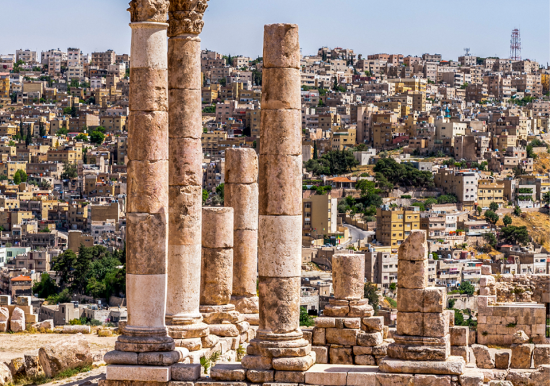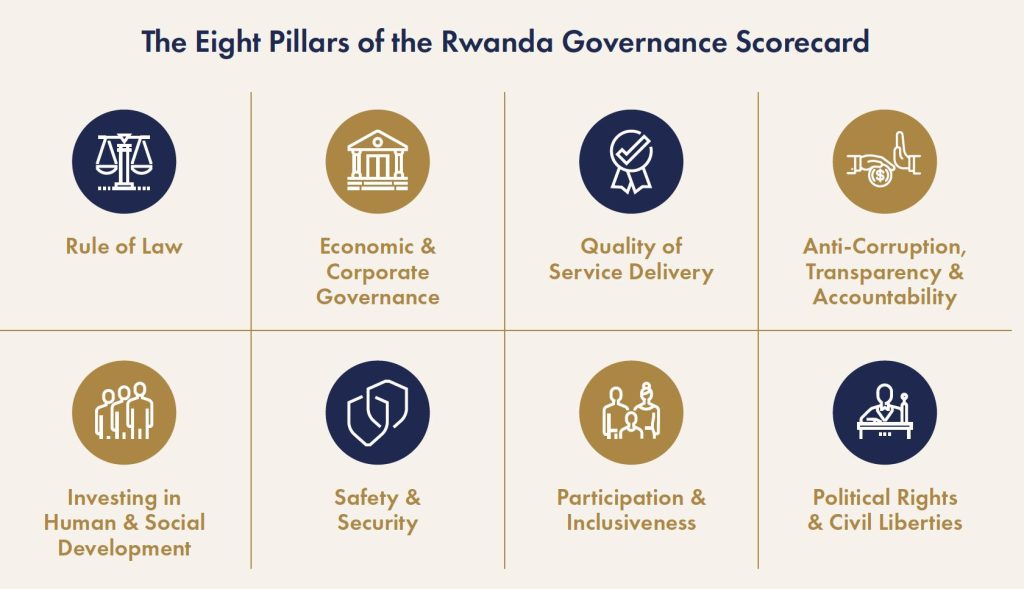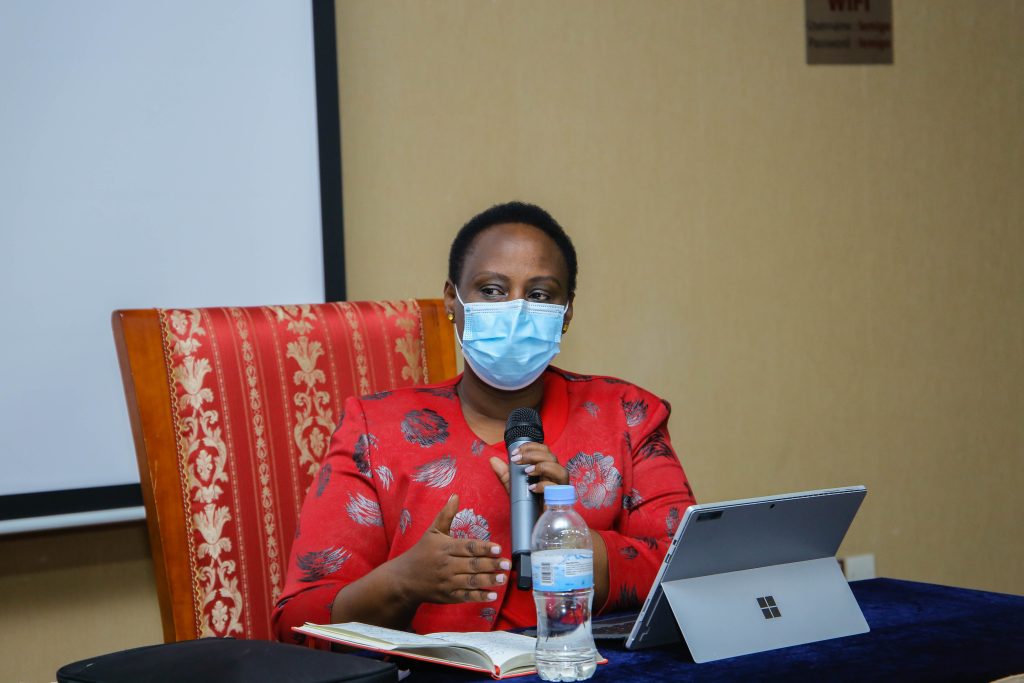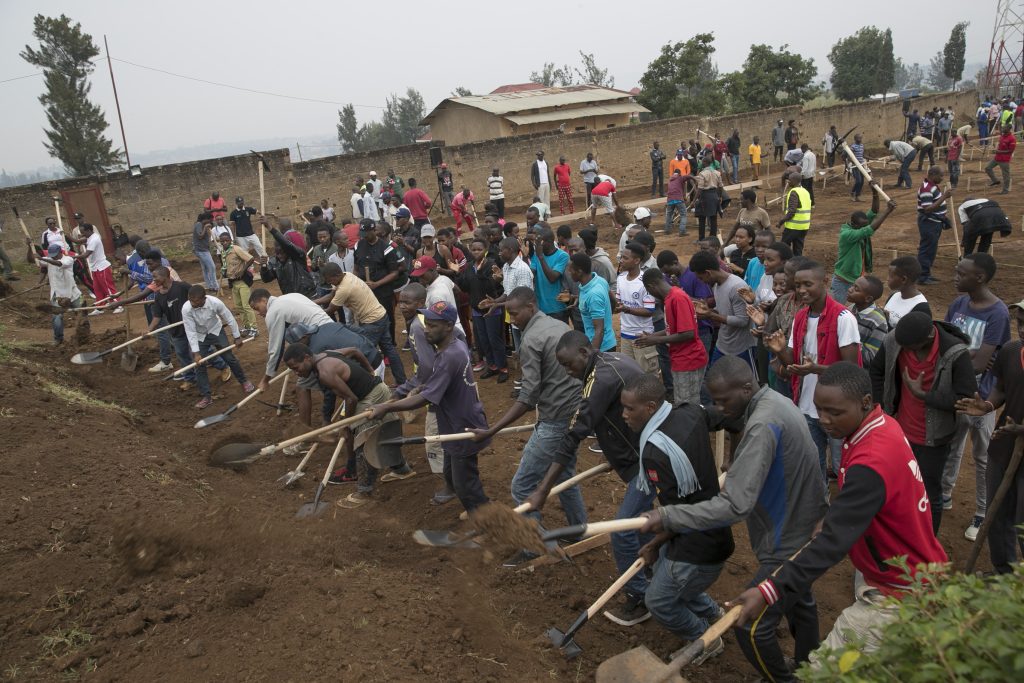
The Power of Accountability: Rwanda Measuring Its Way to Good Governance
Rwanda is ranked 1st out of all low-income countries in the 2023 Chandler Good Government Index and 52nd globally. The nation has jumped up 16 ranks to 40th for Strategic Prioritisation, up 11 ranks to 52nd in the Strong Institutions pillar, and up 19 ranks to 39th for Implementation. We spoke with Dr Usta Kaitesi, CEO of the Rwanda Governance Board, to understand how measuring good governance keeps Rwanda’s public sector accountable to its commitment to good governance.
In 1994, the then UN Secretary-General Boutros Boutros-Ghali described Rwanda, a country being torn apart by civil war and genocide, as “a human tragedy”. From those bloody, bitter divisions, Rwanda charted an improbable course of healing, economic growth, poverty reduction, political stability, and development – only a generation later, Rwanda was often described as a “miracle”, and with good reason. In 1994, life expectancy at birth in Rwanda was 291 years; by 2022 it was 69.62.
Contributing to that progress was the country’s governance, particularly its use of “home-grown solutions” (HGS), which the World Bank credits with “significant improvement in access to services and human development indicators”.3
Rwanda’s commitment to good governance was strengthened by the creation of the Rwanda Governance Board (RGB) in 2011, tasked with, among other mandates, promoting “good governance and quality service delivery”.
To those tasks the RGB brings a data-driven approach, monitoring service delivery and conducting research on governance in Rwanda. It seems to be working. Rwanda has performed consistently well in the Chandler Good Government Index, scoring second-highest overall among sub-Saharan African countries. In the 2023 CGGI, Rwanda moved up three positions in its overall rank to 52nd, and jumped 11 positions in the CGGI’s Strong Institutions pillar.
To get a better sense of how the RGB approaches monitoring good governance, and what other governments might learn from them, the Chandler Institute of Governance spoke with its CEO, Dr Usta Kaitesi.
Set Up to Succeed
In 2016, the mandate of the Rwanda Governance Board was expanded and the institution was strengthened to effectively deliver on this mandate.4 Three key elements are worth noting in this reform.
First, the RGB’s efforts were, from the outset, tied to concrete outcomes – “offering evidence-based advice on policies and strategies”, as Dr Kaitesi says. The RGB shares its insights – in the form of an Annual Report and Action Plan -with key decision-makers, including the President, Parliament, both Chambers, the President of the Supreme Court, and the Prime Minister.
Second, the Law establishing the RGB and determining its mission, organisation and functioning also safeguarded the institution’s independence, helping to maintain the integrity of its operation and findings. “RGB is independent,” the law reads. “In the exercise of its mission, RGB shall not receive instructions from any other institution.”
And third, the RGB’s scope recognises that good governance extends beyond the government. “The RGB regularly monitors the service delivery and compliance with the principles of good governance in the public and private sector as well as in non-governmental organisations,” Dr Kaitesi confirms.
Keeping Score—and Sharing It
Each year, the RGB publishes the Rwanda Governance Scorecard (RGS) reflected as the state of governance in Rwanda”, that Dr Kaitesi calls “a crucial tool that tracks the country’s performance in relation to the national, regional and global governance commitments and targets.”
The RGS is built on eight pillars that are comprised of 35 indicators and 144 separate variables and, “these variables and indicators actually reflect our national priorities,” says Dr Kaitesi.
Stephen Rodrigues, former UNDP Resident Representative in Rwanda, has called the RGS “an important tool for all State actors to assess their work, appreciate their achievements, and recognize areas requiring attention.”5 Jendayi E. Frazer, former US Assistant Secretary of State for African Affairs, called the Scorecard “a credible and world-class policy tool based on universal standards of good governance”6.
Connected to National Strategy and Targets
“We have the National Strategy for Transformation (NST1) as a medium term implementation framework our national vision. The NST1 has three major pillars: economic transformation, social transformation, and transformational governance. The RGS assessment is based on priorities and targets of NST1 and sector development strategies”, says Dr Kaitesi.

Using Data to Inform Action
One goal of the Scorecard is “generating credible and reliable data on governance, serving as an evidence-based source to inform policy, decision making, and implementation.”
Each RGS edition concludes with policy recommendations. Some of the policy recommendations in the recent RGS are reducing the backlog of court cases and improving the role of non-state actors, specifically civil-society organisations, in promoting good governance and the fight against corruption. The RGS also tracks the progress being made against policy recommendations from earlier scorecards, as well as the government’s long-term performance across key pillars. It also serves as a tool that assesses the implementation of the Sustainable Development Goals (SDGs) by Rwanda, especially for Goal 16 related to promoting peaceful and inclusive societies, providing access to justice for all and building effective, accountable and inclusive institutions at a all levels.

Giving Citizens a Voice in the Scorecard
A unique feature of the Governance Scorecard, Dr Kaitesi points out, is its use of data from the study of citizen satisfaction governance and service delivery known as the Citizen Report Card (CRC).
The CRC, built on data collected from around 10,000 households, acts as both a standalone report that feeds into the Rwanda Governance Scorecard, “allowing a direct citizen voice as one of the RGS’s data sources,” says Dr Kaitesi. “We ask citizens how they appreciate services, how they appreciate participation, and how they appreciate the performance of government and service providers across the 16 sectors of service delivery,” says Dr Kaitesi. This offers a data-driven picture of how the government is progressing against the 90% target of citizen satisfaction with government service delivery by 2024 as per the NST1.
The CRC, Dr Kaitesi points out, is more than a valuable research tool. It’s also a way for the government to track progress on an important national targets, a space for citizen participation, and a way for citizens’ voices to be heard and shared with leaders.
Resources for the Citizen Report Card
“To create the CRC we need resources, and a big budget. As we speak now my team is in the countryside moving around homes collecting data. It’s a rainy season, so sometimes you see them pushing their cars off the mud”, says Dr Kaitesi.
The RGB also makes use of technology. “We use SurveyToGo as one of the recent tools for data collection using mobile devices such as tablets or mobile phones. We have tablets that help with data collection fitted with GPS to help monitor whether the survey is being done as planned”, says Dr Kaitesi.”
In this process, the critical resource, Dr Kaitesi says, is the human one. “We need research skills and knowledge within the institution hence the need to consistently train our research team on research methods, data analysis and report writing” Dr Kaitesi emphasises.
Virtuous Cycle of Trust and Impact
Asked about what underpins the success of the CRC, Dr Kaiteisi begins by talking about trust. “Our citizens have trusted us to give us the information,” she says. “This trust is earned, in part, because they know their voices can have an impact. We give our report to the Parliament, both the Senate and Chamber of Deputies together and this serves as a basis of holding institutions accountable on issues raised by citizens.”
It has taken time and persistence. “When we started, we were requesting districts to find space for us to share CRC findings but today, the demand from districts for us to share these findings is huge because they want these findings to inform their next action plan” says Dr. Kaitesi.
Lessons from the RGB
The Power of a Shared Vision
“Governments that seek to set up a particular governance monitoring institution like RGB should, first of all, determine the mission and responsibilities that will be assigned to that institution, based on the needs of the citizens,” says Dr Kaitesi when asked how other nations might emulate the RGB’s successes. In other words, start with a clear picture of why before diving into the what or how. “When I spoke about the Scorecard, I started on the commitments that exist at a national level, I started with a shared vision, I started with the strategies. Almost every country now is interested in producing a report on how they are doing on the UN’s Sustainable Development Goals – that might be common ground to get started”, says Dr Kaitesi.
The Importance of Political Will and Culture
Two other crucial ingredients to factor in, according to Dr Kaitesi are political will and a culture of accountability. “There is an intentional leadership approach that instils a culture of holding ourselves accountable,” she says. “When you determine to hold yourselves accountable, under any institution, you create systems that are going to be fair in the process of holding one another accountable. When you look at the trajectory of how the Rwanda Governance Board was created, we were given the autonomy to exercise our research and the obligation to disseminate the results to inform policy and action. That is exactly what it says in our law. So the clarity of the mandate is also very core to informing action. When we publish our results, we share them both at the strategic and delivery levels. We go to district councils and their partners to show them what the citizens say”, says Dr Kaitesi.
When you determine to hold yourselves accountable, under any institution, you create systems that are going to be fair in the process of holding one another accountable
Dr. Usta Kaitesi, Chief Executive Officer, Rwanda Governance Board, Rwanda
Ongoing Commitment, Not One-Off Support
The way RGB is designed shows that when a monitoring body is well structured and empowered, it pays dividends in the long run. It also reveals that, for monitoring and measuring to be truly effective, it requires continuous support and empowerment. “There is government commitment to empower and support such institutions such as RGB to perform their responsibilities with independence to be able to inspire meaningful impact in delivery”, Dr Kaitesi says.
Learning from the Source
For those desiring to learn from RGB’s experiences, Dr Kaitesi recommends connecting with the institution directly. “We have hosted a good number of countries, particularly from Africa, to discuss how we produce the scorecard”, says Dr Kaitesi. “We also did the same exercise with the African Peer Review Mechanism (APRM) which is an African self-monitoring mechanism. I would really encourage countries to introduce self-assessment mechanisms to inform their progress and inform evidence-based actions. This year we are producing the 10th Rwanda Governance Scorecard; we’ve acquired experiences along the way on how we measure ourselves with the right purpose and intention of informing progress”.
Homegrown Solutions: “The Bedrock of Rwanda’s Reconstruction”
Part of the RGB’s mission is to “preserve, protect, and promote the use of home-grown solutions in Rwanda and devise strategies meant for applying them efficiently”. One of the guiding principles of RGB which helps to implement this mission is “promoting a culture of home-grown innovations in performance and governance”.
But what are Rwanda’s home-grown solutions and innovations (often referred to as HGS)? And why do they receive such focus—not only in the RGB’s mandate, but also in Rwanda’s Constitution.
HGS are “Rwanda’s trademark solutions developed by Rwandans based on local opportunities, cultural values, and history to fast track their development7. “Rwandans, based on their values, initiate home-grown mechanisms to deal with matters that concern them in order to build the nation, promote national culture, and restore dignity… they have been the bedrock of Rwanda’s reconstruction and transformation journey after the 1994 Genocide against the Tutsi”, Dr Kaitesi says.
“Rwandans were faced with seemingly insurmountable problems – the country had a deep social divide and faced a difficult international environment,” reads one summary of Rwanda’s HGS.8 “However, they were determined to pursue unity and self-reliance and were thus compelled to find innovative solutions. To do so, they used one of their most valuable social resources that were available: their cultural heritage.”

One of most the most impactful HGS is Imihigo literally translated as performance contracts. In Dr Kaitesi’s words, Imihigo is “a performance-based management tool to strengthen strategic planning and management, promote socio-economic development, accountability, and to improve service delivery.” Other institutions use performance contracts, however, Imihigo’s cultural roots make it unique, not only in name, but also in heritage. This practice is inspired by the way leaders and chiefs used to set time-bound targets or goals. Far from being solely a top-down directive, Imihigo was also implemented at the local level, where citizens interacted with their leaders which created a greater sense of ownership and responsibility for success.
The other HGS that Dr Kaitesi spoke about was Ubudehe, a programme designed to promote self-governance among local communities. “We have chosen a governance system as a country that is citizen-centred. Ubudehe facilitates programmes that permit citizens to create local projects. In this respect, a given amount of money is set aside, and given to the community to agree on a collective project that can be funded. Such projects may include; building a health clinic, building a house for a vulnerable family, or supporting a business by giving it seed capital. A community can even decide to work with another community to create a joint income-generating project that responds to specific local needs”, Dr Kaitesi says.
The existing home-grown solutions span the fields of governance and justice, economy, and social welfare, as shown in the table below:

While Rwanda’s home-grown solutions differ in detail, all share some common traits: they are anchored in the country’s heritage and culture; they are created by Rwandans to meet their needs; they are conveyed in Rwanda’s own language; and they are meant for a common purpose.
Endnotes
- NISR, Rwanda Vital Statistics Report 2020, p. 4.
- National Institute of Statistics of Rwanda, 5th Population and Housing Census, Rwanda, 2022
- https://www.worldbank.org/en/country/rwanda/overview
- Law N° 56/2016 of 16/12/2016 establishing the Rwanda Governance Board and determining its mission, organisation and functioning.
- RGS, 9th edition, p. 76
- Ibid., p.77
- https://www.rgb.rw/1/home-grown-solutions
- Rwandapedia. (n.d.). What are HGI. Rwandapedia. Retrieved April 12, 2023, from https://rwandapedia.rw/hgs/what-are-hgs

Dr. Usta Kaitesi
Chief Executive Officer, Rwanda Governance Board, Rwanda
Dr Usta Kaitesi is the Chief Executive Officer of the Rwanda Governance Board (RGB). She is also a commissioner in the Rwanda Law Reform Commission. Dr Kaitesi previously served as the Deputy Chief Executive officer of the RGB, the Principal of the College of Arts and Social Sciences of the University of Rwanda and served in different capacities at the UR Law School. She was the Vice Chairperson of the technical support commission to the parliament of Rwanda for the Review of the Constitution of the Republic of Rwanda in 2015. Kaitesi was a member of the Rwanda Bar Association and the East African Law Society. Kaitesi holds a PhD in Law from the University of Utrecht, the Netherlands, a Master of Laws from the University of Ottawa, Canada, and a Bachelor’s degree in Law from the then National University of Rwanda.
More Stories


Global Influence & Reputation Country Snapshot: Türkiye

